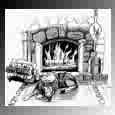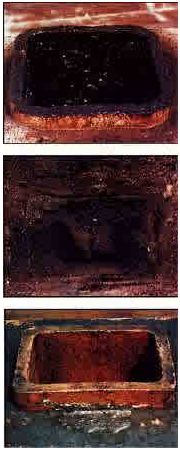|
|
SWEEPS
Why You Should Have Your Chimney Swept Regularly!
A. The short answer is because you life and property are at risk if you don't.
B. The National Fire Protection Association recommends that homeowners get their
chimney inspected at least annually.
C. Regular annual chimney cleanuings are an important maintenance concern. Besides
creosote buildup, rainwater damage is the number one cause of chimney deterioration.
It's Importatn To Note:
When shopping for a chimney sweep, be sure to consider the old saying, "You get
what you pay for". There are a handful of companies in this area offering to
clean chimneys for about 1/2 of the going rate. These companies often do not take
the time needed to do the job properly, as they must move to the next house quickly
in order to off-set their low prices. These
low-dollar companies will often skip the smoke shelf and smoke chamber areas
directly above the damper in the fireplace cleanings, leaving all of the creosote they
may have brushed down the chimney sitting right there on the shelf and only clean
from the top of your chimney and never venture inside at all during their whole visit.
This can create many problems for you the consumer; open fireplace doors and open
dampers create an excellent pathway directly into your living space and making an
aweful mess. Also buyer beware of companies that have more than one specialty......
as we call them : "Jack of all trades but master of none." These companies hire any
one off the street and send them out to do whataever is needed at that time. More
"specialties" in a company to get more money is all they are truly interested in, not
quality craftsmanship and professionalism and you the consumer's best interests.
Why Do Chimneys Need To Be Swept?
Sweeping a chimney removes dangerous, flammable creosote from inside the chimney so the
chimney contains no fuel that could ignite. Chimney fires can sound like a freight train (free
burning), or they can smolder and go almost unnoticed by the occupants of the home
(slow burning). In either case, a chimney fire is potentially hazardous. Fire can spread to the
home. If the chimney can do its job and protect the home, it is damaged in the process. Other
factors such as bird's nests and inadequate clearance to combustibles can contribute to structural
chimney-related fires. These factors are equally as important as creosote build up, and are
investigated in the course of a thorough inspection. Sweeping a chimney primarily refers to the
removal of creosote deposits so it is advisable not to disregard "inspections or evaluations" as
unimportant. Chimney sweeping requires laborious scraping and scrubbing with wire
brushes to remove flammable creosote. A chimney fire occurs when a creosote buildup
ignites and burns inside the chimney and stove pipes. Cleaning chimneys, either masonry or
insulated pipe, at least once per year can decrease the formation of creosote and the hazards
caused by the build up.
What Is Creosote?
Creosote is the product of wood smoke and moisture ( a combination of unburned gases and
unburned tar-like liquids). It can be a serious hazard for homeowners who burn wood. Creosote
is formed by burning wet or unseasoned wood, restricted air supply, burning at a low temperature
or cooler-than normal chimney temperatures.
The large amount of moisture from burning wet wood condenses in the chimney and adds to
creosote formation as well as the acrid odor. The formation of creosote can be a nuisance
because it may drip out of stove pipe joints which have not been properly sealed or installed;
leaving a gummy stain and an acrid smell possibly ruining finishes or flooring. When these come
in contact with a cooler surface, they condense on that surface. In your chimney, it can appear
as a black or brown coating. It can be sooty, dry and flaky, sticky, or hard and shiny. These
deposits can reduce draft and cause smoke to spill into your room. Whatever form it takes, it is
highly flammable. If large amounts build up, the result could be a chimney fire (fires which start in
dirty chimneys generate tremendous amounts of heat causing flue liners to crack among other
hazards). Creosote can burn at temperatures up to 3000 degrees Farenheit and can have the
same ignition temperature as a piece of paper.Chimney flues are meant to contain exhaust
gases, not combusiton.
Prevention:
1. Use seasoned woods only (dryness is more important than hard wood versus soft wood
considerations).
2. Build smaller, hotter fires that burn more completely and produce less smoke.
3. Never burn cardboard boxes, wrapping paper, trash or Christmas trees; these can spark a
chimney fire.
4. Keeping your chimney clean will pay off in increased safety and efficiency.
Clean chimneys don't catch fire. If you think a chimney fire has occurred, call us for an
inspection!
How Often Should My Chimney Be Cleaned?
Most chimneys should be cleaned after a cord of wood has been burned. Of course, there are several other factors
that could require a different cleaning schedule:
1. How often you burn.
2. How you manage your fire.
3. The wood you burn.
4. How well seasoned the wood is.
5. The weather.
6. Location and size of chimney (exterior or interior).
7. Improper caps.
8. Overhanging trees.
What Type Of Wood Should I burn?
If at all possible, you should burn hardwoods such as oak, ash, and hickory to name a few. Dry hardwoods,
because of their high-burning temperatures and low smoke density, leave less creosote in your chimney.
After the cleaning we will fill out a written evaluation form and will recommed any improvements or repairs you
may need.
|
|


